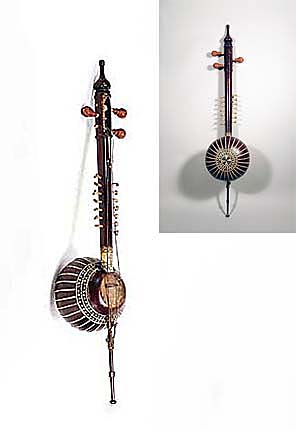
Owner: HWMC
Catalog#: 2ME-CHLT-08
Lutes
Iran ‘Kamānche’ (Persian)
Iran
Iranian
Wood, bone, skin hide, ivory, metal
Late 19th – Early 20th century
Length: 43 inches; Width: 10 inches
Chordophones – Lutes
Kamāncheh is a term applied to several long-neck spiked lutes mainly from Iran, the Caucasus and Turkey. The term kamancheh (in Persian means ‘little bow’) was first used in the 10th century to describe an instrument which is sounded with a bow. Today, there are variations in the structure of this instrument in each of the various regions it is found. This is a kamānche from Tehran, Iran (Persia). It is elaborately decorated with wood, bone, and metal using a mosaic technique called “khatam-kari.” The resonator is a truncated inverse cone which makes it easy for bowing. The small sound table that covers the open part of the resonator comes from goat or sheep skin/hide. The pegbox with a spiral final on top is open in the front for the three main gut strings to feed through to the three pegs (Modern kamānche have four main strings and pegs), while the neck supports 14 sympathetic strings and pegs inserted horizontally. When played, the bottom endpin serves as a foot for the player to rest the instrument on the knee or thigh while held upright and seated in a chair.
